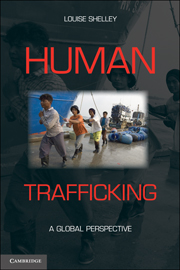Book contents
- Frontmatter
- Contents
- Acknowledgments
- Introduction
- Part I The Rise and Costs of Human Trafficking
- Part II The Financial Side of Human Trafficking
- Part III Regional Perspectives
- 5 Asian Trafficking
- 6 Human Trafficking in Eurasia and Eastern Europe
- 7 Trafficking in Europe
- 8 Trafficking in the United States
- 9 Human Trafficking in Latin America and Africa
- Conclusion
- Index
9 - Human Trafficking in Latin America and Africa
Published online by Cambridge University Press: 05 June 2012
- Frontmatter
- Contents
- Acknowledgments
- Introduction
- Part I The Rise and Costs of Human Trafficking
- Part II The Financial Side of Human Trafficking
- Part III Regional Perspectives
- 5 Asian Trafficking
- 6 Human Trafficking in Eurasia and Eastern Europe
- 7 Trafficking in Europe
- 8 Trafficking in the United States
- 9 Human Trafficking in Latin America and Africa
- Conclusion
- Index
Summary
Latin America and Africa are the two poorest regions of the world. The regions have high birth rates, large youthful populations, and economies that are not growing at the pace needed to absorb the expanding work force. In both regions, societies are highly stratified socially and economically, with large numbers of citizens remaining permanently unemployed or underemployed with limited access to capital. They differ from Asia, discussed in Chapter 5, where there are countries with great wealth, access to capital, low birth rates, and without histories of colonial exploitation.
Much foreign aid is abused, leaving citizens with no prospects for education or a decent livelihood. Many children are abandoned by desperate parents or by families displaced by conflicts or disasters, creating serious problems of street children. High levels of corruption prevail in both regions, particularly in Africa, where government leaders have been especially rapacious. These conditions are highly conducive to human trafficking. Yet, as mentioned in the introduction, the profits of human trafficking from Latin America and Africa are the least in the world. This is not explained by the absence of victims but by the low cost of human life and absence of individual rights. Gender discrimination and machismo in Latin America help explain the disproportionate female victimization, although young boys are not exempt from exploitation.
- Type
- Chapter
- Information
- Human TraffickingA Global Perspective, pp. 265 - 294Publisher: Cambridge University PressPrint publication year: 2010



